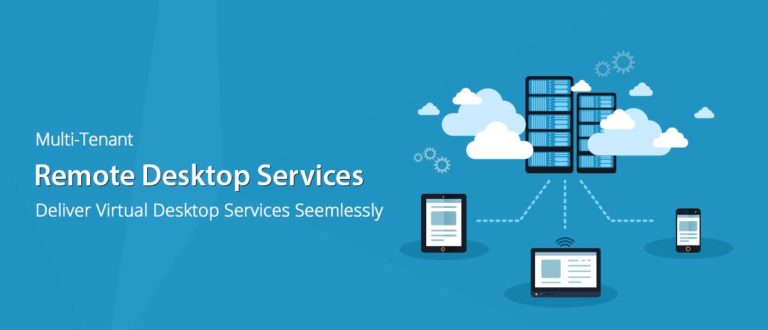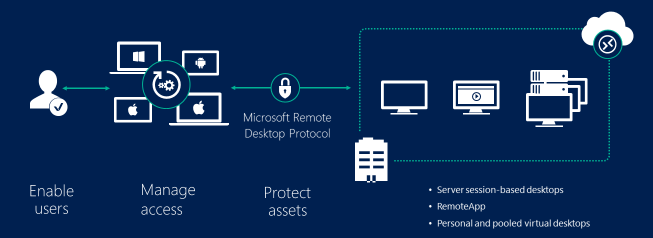
Free Consultation
Remote Desktop Services
RDS
The COVID-19 pandemic has resulted in several paradigm shifts at a global level. The rapid transition to remote working across a large number of industries is one of the welcoming effects of the pandemic. Organizations across the globe have realized the potential offered by technological advancements like Remote Desktop Services (RDS), Cloud Computing, etc. to realize a formidable Business Continuity Plan (BCP).
Remote Working has proven that the right set of technologies when adopted at scale can remove hindrances that hamper employee productivity and business continuity. Remote way of working is no longer a choice but it is the ‘only way’ businesses could thrive in a remote-first business environment.
Deployment of Remote Desktop Services (RDS) is one of the most efficient ways for organizations to provide employee remote access and realize business continuity.
What is Remote Desktop Services (RDS) ?
For businesses looking for 24/7 continuity, it becomes imperative to invest in technologies that provide employees uninterrupted and secure access to the corporate network. In the wake of the COVID-19 pandemic, IT departments across businesses started investing in tools (or technologies) that catalyze remote work and enhance employee productivity.
Remote Desktop Services (RDS) is one of the widely used remote access technologies available in the market. It provides the most efficient way for employees to connect remotely to their workstations.

Remote Desktop Services (RDS) is a high-level term for the features offered by Microsoft Windows Server that lets users remotely access graphical desktops and Windows applications in a secure manner. RDS is built on the client-server architecture where the client(s) can connect to the server and have complete access to the Windows desktop running on the server!
RDS is the most-sought after platform for building virtualization solutions that cater to every aspect of the business. Along with provision for remote and secure desktop access, RDS can play an instrumental role in delivering individual virtualized applications and providing users the flexibility to run their desktops & apps from the cloud.
With RDS, organizations can build a scalable desktop-like environment by maintaining a single server (or a server farm). Depending on preferences and requirements, businesses can choose from a wide range of deployment options with RDS:
- On-prem (or on-premises) deployment with Windows 2016 Server
- Cloud deployment facilitated by Microsoft Azure
- Partner solutions
How does Remote Desktop Services (RDS) work ?
In RDS, the user is remotely connecting to a fully-fledged Windows desktop that is running on the Microsoft Windows Server. The sessions to the remote Windows desktops are secure, end-to-end encrypted; thereby providing users (or employees) the flexibility to work productively even when they are not available in the office.
Deploying RDS at scale results in a significant reduction in tasks such as hardware provisioning, IT infrastructure maintenance, and more. With RDS, one Windows Server has the potential to provide multiple concurrent sessions to numerous concurrent users.
RDS offers multi-fold benefits to end-users and IT administrators. Installation of new packages and software upgrades have to be done only on the Windows server. The upgrades will be available for all the users connecting to the server for establishing a remote session.
RDS also provides additional controls through which IT administrators can limit the number of concurrent sessions to optimize the overall experience.
Users (or employees) working from locations where network connectivity is flaky can still use RDS for remote access, as only the sessions display is transmitted. Latency is a thing of a passé since employees can continually deliver; agnostic of their location!
How to setup Remote Desktop Services (RDS) ?
Based on the environment requirements, RDS can be set up for session-based virtualization and Virtual Desktop Infrastructure (VDI). It could also be a combination of the two.
- Session-based virtualization leverages the immense potential offered by Windows Server to provide a multi-session environment to the users. It is a cost-effective solution that is best-suited for early-stage and growth-stage enterprises.
- Virtual Desktop Infrastructure where the desktop environments are hosted on the central Windows Server. It is best suited if the organization aims to provide a Windows desktop experience to the end-users.
RDS also provides the flexibility where IT administrators can choose what has to be published to the end-users within these virtualization environments:
- Remote Desktops: The users can experience a complete desktop experience by establishing sessions to the Windows Server. Businesses looking to minimize the overhead on in-house IT infrastructure should choose this option.
- Remote Apps: The specified apps are run (or hosted) on VMs (Virtual Machines) with minimal (to no) latencies. Users witness a blazing-fast app experience, as if the apps are accessed from local machines.
It is ideal for businesses that plan to leverage the potential offered by Remote Desktop Services (RDS) for deploying and managing apps in a remote & secure environment.
Why Remote Desktop Services (RDS) is ideal for a remote-first digital workplace?
Remote Desktop Services (RDS) is an extensively used technique through which users can deploy an app or work on a full desktop environment that is available by establishing a session(s) with the Windows Server. While compute operations are performed on the cloud, a desktop-like experience is made available to the users (without any additional installation on their devices).
With Remote App and Remote Desktop, RDS provides the ideal options for enterprises where they can choose to deliver a consistent desktop experience to their users (or employees) or deliver apps to end user’s devices in a secure manner.
This is how embracing Remote Desktop Services (RDS) can help your organization in the long run:
Ease in Management
Deployment of Remote Desktop Services (RDS) results in minimizing the overall burden on the IT department. IT administrators have to spend less time maintaining the IT infrastructure.
Managing multiple operating environments is simplified with RDS, as IT administrators have to deploy the updates (or changes) in a single instance and it is available for all the users of the instance. There is no learning curve, as RDS offers a familiar desktop experience that is known to the users.
Increased Security
Whether it is a Remote App or Remote Desktop, RDS does not face any compatibility and security issues. In both cases, compute is performed on the cloud and the data is confined to the organization’s secure network.
Additional security levels can be set by the IT administrators by setting rules to prevent unauthorized access and disable the storage of data in unapproved locations such as pen drives, external hard disk drives, etc.
Lower Configuration Time
The data is stored in the cloud for Remote Desktops and Remote Apps. With a minimal dependency on the local device, it becomes easy setting up or configuring new devices with RDS. The app experience and desktop experience is delivered from the cloud.
Once the device used for connecting to the remote Windows server is setup, users can seamlessly establish remote desktop sessions or connect to the remote apps with ease.
Reduction in overhead IT expenses
The COVID-19 pandemic was a reminder for organizations to focus on building a scalable and reliable IT infrastructure – an infrastructure that ensures that ‘business should go on as usual’! This meant investing critical financial resources in strategic initiatives that help the enterprise in the long run.
Uninterrupted Remote Access is a must-have for business growth and Remote Desktop Services (RDS) is the essential tool in realizing this requirement. Adopting RDS helps in minimizing the overall cost in maintenance of the on-premise (or in-house) IT infrastructure. This in turn helps in minimizing the costs involved in running the IT operations.
Greater Uptime, Improved Productivity
It is a known fact that network downtime can have a negative impact on business outcomes, employee productivity, and overall revenues. An increased amount of downtime can badly hurt the brand’s image. The ideal solution for minimizing the downtime (or improving the uptime) is investing in solutions that have built-in redundancy.
Remote Desktop Services (RDS) holds the key to building a resilient IT infrastructure. Depending on the size and scale of the organization, multiple instances of the same RDS solution can be deployed across a number of servers. Though this results in creating redundancy in the IT infrastructure, it ensures maximum uptime and reliable connectivity – key factors for realizing business continuity.
Processing Prowess
In an RDS environment, the client is primarily responsible for establishing a remote session with the Windows Server, and processing is done on the server. In a traditional IT infrastructure, the processing capability depends on the architecture of the user device (or machine). Machines with outdated architectures are not suited for performing CPU-intensive and memory-intensive applications.
The end result: decreasing productivity that negatively impacts the business outcomes.
RDS is capable of serving a large number of concurrent users without any issues. Continual connectivity results in improved end-user productivity.
The IT team no longer has to maintain (or upgrade) multiple devices since updates are pushed only to the central Server. The Total Cost of Ownership is much less – the benefits of which will be evident across departments (in an organization).
In a nutshell, deployment of Remote Desktop Services (RDS) is the preliminary step to build a resilient and scalable IT infrastructure.

